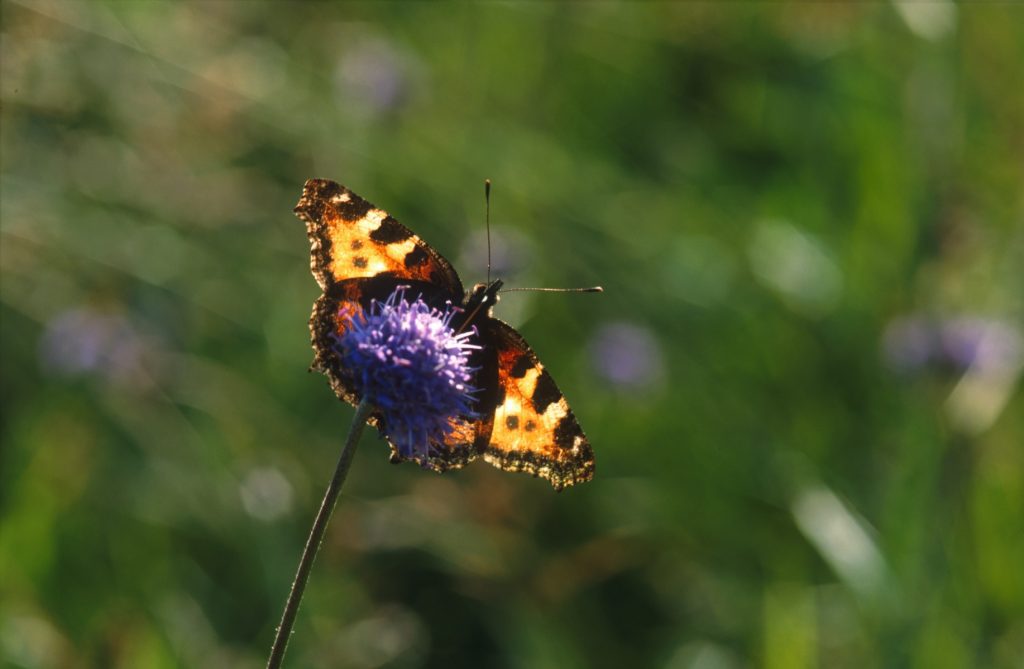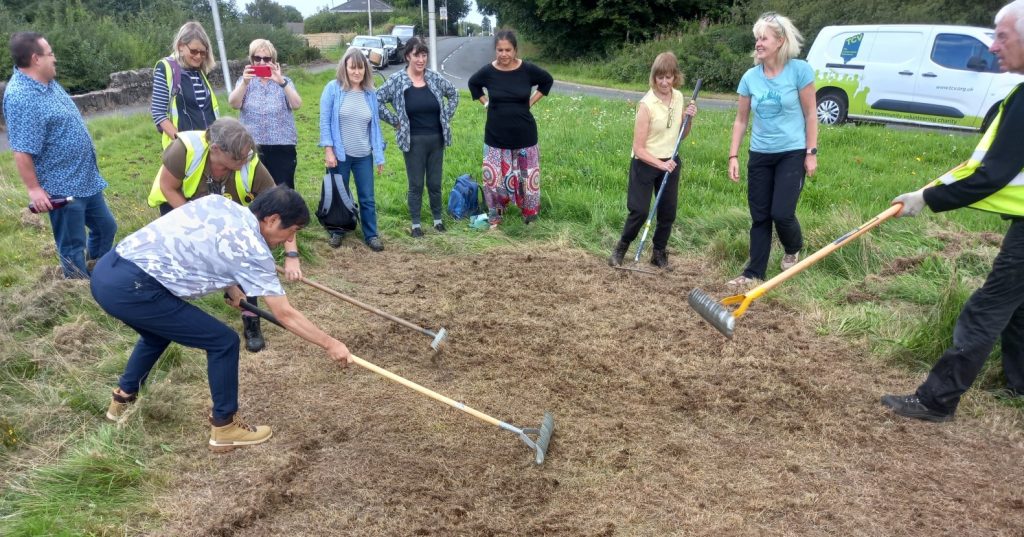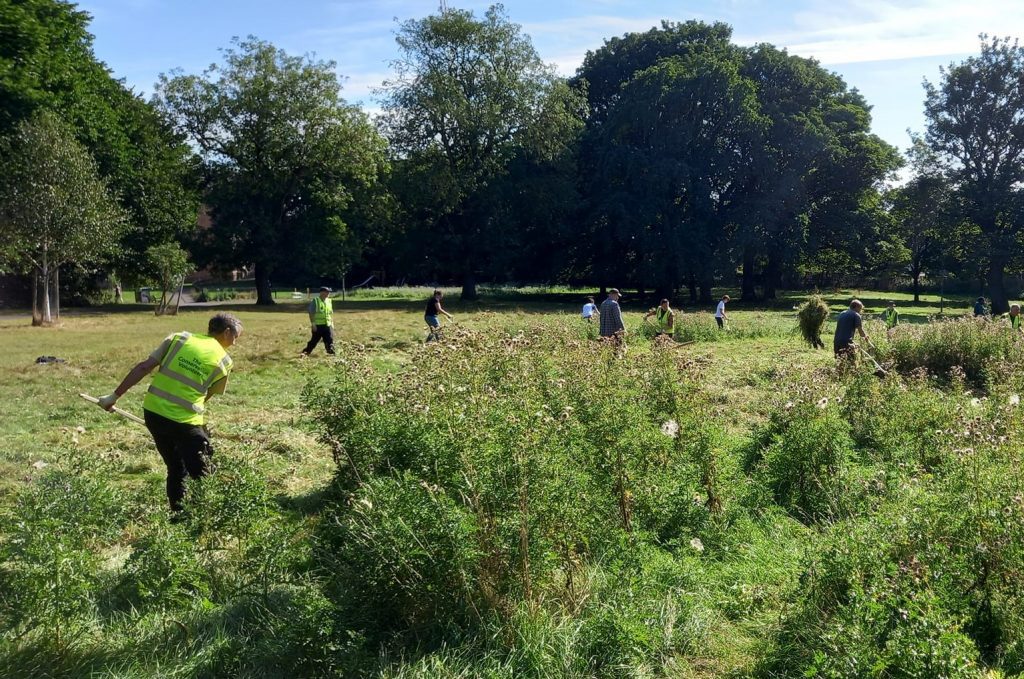Camilo Brokaw is a Senior Project Officer in Scotland
One of the most dramatic statistics in UK nature conservation is that we have lost over 97% of our wildflower meadows since the 1930s, mainly due to changing farming methods and urban expansion. A meadow is a rich mix of native wildflowers and grasses, which were traditionally allowed to flower before a hay cut in the summer, followed by grazing from livestock.
Wildflower meadows are not only visually stunning, but they also support a plethora of wildlife, including small mammals, birds, and pollinating insects like bees and butterflies. We can help reverse the loss of this valuable habitat by creating new wildflower areas and meadows. However, establishing a wildflower meadow requires a thoughtful approach. Here’s a beginners guide to help you on this beautiful journey.

Observation is Key
Before jumping into creating a meadow, take time to observe the current state of your site. You should assess the following:
- Species present: a diverse range of species can indicate a healthy ecosystem.
- Health of the grass: dense, vigorous grass might hint at a nutrient-rich soil. Wildflowers prefer nutrient-poor soil.
- Drainage conditions: puddles or waterlogged areas might need bog plants if drainage can’t be improved.
- Soil pH: certain plants prefer acidic or alkaline soils. Look for the presence of several indicator species such as buttercup, sorrel, and docks (acidic) or chamomile, sow thistle, and chickweed (alkaline). Alternatively, use a simple pH test kit to assess your soil.
Assessing the Right Location
The observations above can guide you in determining if the location is suitable for a meadow and which seeds would thrive best.
Preparing the Ground
Depending on the health and vigour of the existing grass, you may need to:
- Reduce soil nutrients to limit competition from grasses. One way is by removing the top layer of soil. Lifting the turf will also reduce the competition of well-established grass.
- Scarify the soil, which means scratching the surface, to make it more receptive to seeds. When the ground does not have anything growing very vigorously it may be low in fertility as it is and only needs exposed soil to sow seed.
Please note that while chemical controls can be tempting to manage unwanted species, they can negatively impact the vital fungal partners in the soil.
Seed Selection & Sowing
Till the soil with a rake until you achieve a fine soil particle size optimal for seed germination. When to sow? Both autumn and spring have their merits.
Autumn sowing: seeds benefit from the natural stratification process during winter, leading to better germination in spring.
Spring sowing: the ground is not left bare for as long and seeds that don’t need cold temperatures will be quick to get started.
Choose a seed mix with a good variety of species, such as a meadow mix from Scotia Seeds (typically 20% wildflowers, 80% grasses) unless you have ascertained you have more specific conditions you can select seeds for.
It’s important to know the life cycle of the wildflowers and grasses you are sowing:
- Annual plants germinate, flower, set seed and die in one year.
- Biennial plants germinate and grow one year, and flower and die in year two.
- Perennial plants flower and ‘die back’ each year but grow back again in following years.
Whilst some meadow seed mixes include some annual wildflowers to give an early burst of colour eg corncockle and cornflower, most meadow mixes are of perennial species, so you aren’t effectively starting from scratch each year.
When spreading seeds, a useful tip is to mix your seeds with dry sand or sawdust, so you can see where your seeds are landing to ensure an even spread. Gently walk over the area so the seeds have good contact with the soil, and water lightly.
Here, we’ve considered the use of wildflower seeds, but in some situations wildflower ‘plugs’ may also be suitable, as explained by Plantlife.

Maintenance in the First Year
To ensure your newly sown wildflowers aren’t overshadowed by competing species, cut the meadow three times during the first year. This will give your wildflowers the best chance to establish. Cut to about 5cm off the ground. You can use a mower or strimmer, but many conservation groups prefer manual scything as it’s less likely to harm any wildlife.
In this and subsequent years, leave the cuttings for about a week which will allow the seeds to fall off. You then need to rake up and remove the cuttings, called arisings, as leaving them will add unwanted nutrients to the soil. Cutting and removing the clippings mimics the hay cutting and grazing cycles of traditional meadows.

Ongoing Care
From the second year onwards, an annual cut should suffice in August or September when most plants have set seed. Continuously observe the species in your meadow. Hand-weeding invasive species and adding more seeds can enhance diversity. It’s important to avoid one species becoming dominant.
Community learning
I recently had the pleasure of delivering meadow ecology workshops in Renfrewshire for the Inchinnan Development Trust, Jenny’s Well volunteers in Paisley, and Bee Happy Houston. I’m excited to be running more free meadow ecology and creation workshops in Glasgow this autumn, so keep an eye on our social media and Eventbrite.
“We were so pleased with the turnout and had some really great feedback from those who attended – everyone’s feeling ready to get started with some more ground prep and sowing this autumn!” – Inchinnan Development Trust
Creating a wildflower meadow is a journey, one that is rewarding not just for us, but for the environment and the species that call it home. Happy gardening!
To learn more about meadow creation and management, there are plenty of sources available, such as: TCV’s How to Create Wildflower Meadow Guide, Plantlife’s The Good Meadow Guide, TCV’s ten comprehensive Conservation Handbooks cover the main aspects of habitat and greenspace management and are available through online subscriptions, with discounts for Community Network members.

If you do not live in Scotland and would still like to get involved in meadow creation work with TCV, you can find local opportunities near you here.
_______________________________________
Keep up to date with the latest news and activities from The Conservation Volunteers by following us on Twitter, Facebook, LinkedIn and Instagram. You can also sign up to receive our Greenzine newsletter for more ways to get involved.




